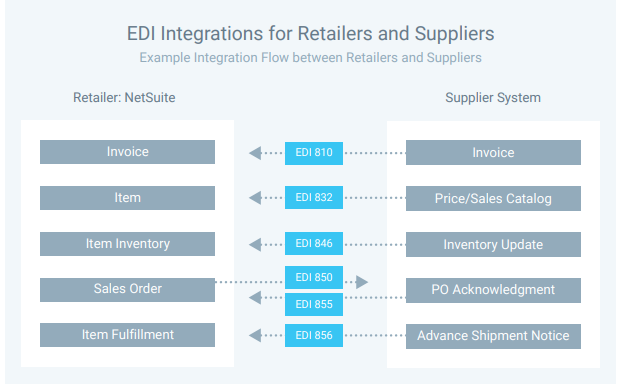
Introduction
Many large companies require their vendors and suppliers to use Electronic Data Interchange (EDI) for their data communications. E-commerce businesses that seek to become suppliers to retailers like Amazon, The Home Depot, Target, Walmart, Wayfair, etc., or who work with suppliers, manufacturers, 3PLs, shipping companies or other logistics providers, will at some point be required to support EDI.
We will walk you through what EDI is and why EDI integrations are essential to your business. We’ll discuss why it’s important to integrate EDI with your ERP. We’ll share some of the integration options available to you, as well as some common EDI integrations specifically for NetSuite.
What is EDI?
Electronic Data Interchange (EDI) has been around since the early 1970’s and was created as a standards-based way for companies to send information electronically. While EDI covers a range of industries, from insurance to government to pharmaceuticals, for our purpose, we’ll define it as a way of integrating Business-to-Business (B2B) commerce entities (trading partners) using a standard format.
The goal of EDI in this context is to provide standards that map business processes and standardize how transactions are managed and communicated between companies: i.e., how orders are placed, fulfilled, and tracked, how inventory is managed, and so on.
Why EDI?
EDI helps companies eliminate paper-based communications by automating and streamlining B2B communications. The use of standard EDI formats throughout the commerce supply chain — from manufacturers, distributors, retailers, fulfillment providers, and other trading partners — has allowed retail companies to fulfill orders faster, cheaper, and with fewer errors.
Many of the world’s largest retailers major players use EDI; companies like Amazon, Home Depot, Target, Macy’s, Walmart, Wayfair, and others. Why? EDI is a proven and trusted technology. They have made significant investments in the technology and it works for them. EDI has solved a lot of real problems, from standardizing date formats to the tracking of individual units. And, by mandating their business partners use EDI, these companies have eliminated their need to spend time and money on mapping information between each partner or application.
If you work with companies that use EDI, you will need to figure out a way to integrate your applications so they can accept and send EDI files. Without an effective integration, you will be burdened with an enormous amount of manual work to support the myriad documents associated with EDI.
Another thing to keep in mind is that while EDI standards are available, companies typically create a customized version for their specific use. The most common EDI standards in use are EDI X12 and EDIFACT. Even when companies are using the same standard, slight customizations will most likely need to be done based on customized formats used by each individual company.
Common EDI Integrations for NetSuite
The primary objective of EDI integration is to streamline communications with your trading partners. If you are just processing a small number of orders, you may be able to manually upload and download EDI documents between your partner’s portal site and your back-office systems. However, as the number of orders increases or you work with other vendors that use EDI, manual processes can quickly lead to delays and errors.
Many retailers use an ERP, such as NetSuite, as their business financial system, so integrations between your trading partners or EDI networks and NetSuite are commonly required.
But, keep in mind that from a business process perspective, flows for orders, inventory, catalog, inbound shipments, invoicing, shipment acknowledgments, etc., all have to be in place regardless of whether your trading partner uses EDI or another method to transfer information between applications.
It’s possible that you might work with one provider that uses a REST API. You might work with another provider that works with CSV or flat files. And another that uses EDI. The bottom line is, you are responsible for ensuring that information is up-to-date and synchronized between applications. And, if you work with multiple trading partners, these flows are not going to follow the same business processes. Taking this multi-flow scenario into account is essential as you’re planning your EDI trading partner integrations.
As an example, let’s look at three EDI integration scenarios for NetSuite: Retailer, Supplier, and 3PL integrations.
EDI Integrations with Retailers
Companies that sell to big box retailers, such as Macy’s, Nordstrom’s, Target, and Walmart, are typically required to use EDI to exchange purchase orders, invoices, inventory levels, product details, shipment, and other key information. Some retailers mandate that their suppliers integrate to an established EDI VAN, such as DSCO for Nordstrom. Other companies give flexibility with the option to either directly integrate to the retailer FTP server or via EDI networks, such as Commerce Hub and SPS Commerce.
As a supplier to retailers, you will need to make sure the flavor of EDI required by your trading partners are supported by NetSuite.
Supplier: NetSuite --- Retailers
Sales Order <--EDI 850-- Purchase Order
Shipping Confirmation <--EDI 856-- Advanced Ship Notice
Invoice <--EDI 8106—Invoice
Inventory –EDI 846--> Inventory Update
If you are selling to Amazon, your EDI integrations will need to support EDI 753 and 754 to track routing requests and instructions. These documents are typically not used by other retailers so you may need to build out the support for these special document types.
EDI Integrations with Suppliers
If you need EDI integrations with your manufacturers or distributors, your NetSuite integrations will be the reverse of the prior scenario where you are the supplier. Similar to working with a retailer, you will need to make sure you account for all the EDI documents that will be exchanged to support your interactions with your supplier.
Retailer: NetSuite ---- Supplier System
Invoice <--EDI 810-- Invoice
Item <--EDI 832—Prices/Sales Catalog
Item Inventory <--EDI 846-- Inventory Update
Sales Order --EDI 850--> PO Acknowledgment
Sales Order <--EDI 855-- PO Acknowledgment
Item Fulfillment <--EDI 856—Advance Shipment Notice
EDI Integrations with 3PLs
Many businesses, large and small, use third-party logistics (3PLs) to outsource all or part of their distribution and fulfillment services, such as 3PL Central, Amazon Fulfillment, Expeditors, Shipwire, and UPS.
There are several common flows that you need to consider when integrating a 3PL with NetSuite.
- Outbound Orders
- Sales Order export to 3PL
- Order acknowledgement from 3PL
- Shipment Confirmation from 3PL
- Inventory
- Inventory Adjustments from 3PL
- Inventory Snapshots from 3PL
- Catalog
- Item Catalog Export to 3PL
- SKU Profile from 3PL
- Inbound Shipments
- PO export to 3PL
- PO Receipt from 3PL
- TO export to 3PL
- TO Receipt from 3PL
- Return Authorization to 3PL
- Return Receipt from 3PL
One challenge is that a 3PL may not support all of these flows in the same way; for instance sometimes a 3PL will do one “leg” of the flow via EDI, while another flow – like a real-time inventory snapshot – might be done via an API call. You need to understand these distinctions and take all of the different flow scenarios into consideration when planning your 3PL integration.
Since this integration challenge is your responsibility, you need to understand your options when it comes to ensuring a viable integration with your EDI trading partner
Contact Us for more information on Integrating EDI and NetSuite into your Business.
Copyright © 2025 - Custom Software Solutions, Inc.







